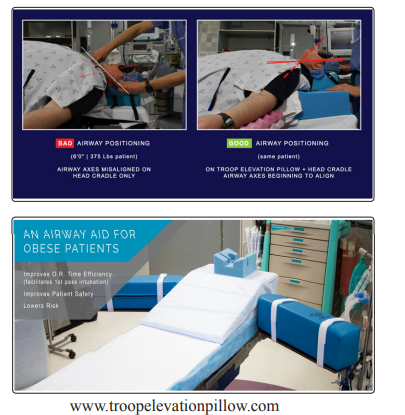Author(s): Craig Troop MD
Intubating obese patients can be challenging, especially when the patient is lying flat. Studies have shown that positioning the obese patient on a ramp can increase first pass successful intubation and help prevent complications. Elevating the obese patient’s head, neck and upper chest such that the ear and sternal notch are more horizontal to the O.R. table (the white line in the image) will help to align the airway axes. The three airway axes are shown as super imposed red lines in the image.
Intubating obese patients can be challenging, especially when the patient is lying flat. Studies have shown that positioning the obese patient on a ramp can increase first pass successful intubation and help prevent complications. Elevating the obese patient’s head, neck and upper chest such that the ear and sternal notch are more horizontal to the O.R. table (the white line in the image) will help to align the airway axes. The three airway axes are shown as super imposed red lines in the image.
The ramped position, Head-Elevated Laryngoscopy Position (H.E.L.P.), is recommended for obese patients over the conventional sniff position because it provides a better (alignment of the airway axes). H.E.L.P. “opens” the sub mental space between the mandible/chin and sternum, allows for improved pulmonary mechanics (easier mask ventilation) and assists with cricoid-laryngeal cartilage manipulation.
Current practice is to create a ramp by stacking a pile of blankets underneath the obese patient. Not only is it time consuming to stack the right number of blankets so the patient is in the correct position, but having a patient on a pile of blankets can be very unstable and lead to unpredictable results.
The Troop Elevation Pillow (TEP) is designed to quickly achieve H.E.L.P. The TEP gives health care providers an improved starting position for airway management. This helps to give patients improved ease-of-breathing, a higher pre-oxygenation level (pre induction) and a longer time to desaturation (post induction). Clinical studies and national educators strongly support ramping obese patients in the Head Elevated Laryngoscopy Position. The improved starting position can also facilitate first pass successful intubation, meaning a quicker time to incision and therefore better OR time management.

